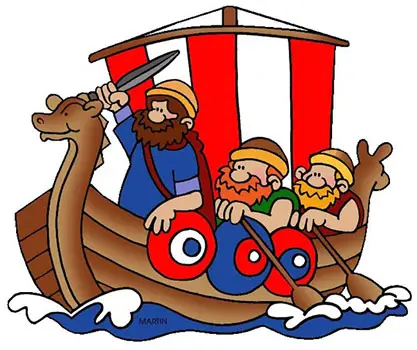The Vikings
Around 800 CE, various peoples from Scandinavian regions sailed away from their homelands and began raiding other areas of Europe. These pirate Norsemen (“Northmen”) became known as Vikings, from the old Norse word for bay or creek: vik.

Vikings raided coastal sites, including undefended monasteries in the British Isles and spread fear throughout Europe. For over 100 years, they controlled most of eastern England and also parts of France, especially Normandy.
Some Vikings eventually settled in conquered areas or focused on trading, but others continued raids until the 11th century.

Culture
The earliest Vikings practiced their own forms of pagan religion. Later Vikings converted to Christianity. They spoke a language called Old Norse. Vikings decorated useful objects, such as swords, and crafted beautiful jewelry.
Early Raids
793 – The attack on Lindisfarne Monastery on the Northumberland coast of Britain marks the beginning of the Viking era. The marauders probably came from what is now Norway. They did not destroy the monastery, but news of the attack spread through Christianized Europe and spread fear. As non-Christians then, Vikings had no respect for religious institutions.
795 – Vikings raided monasteries on the northern islands of Skye, Iona and Rathlin.
799 – The first recorded Viking raid in continental Europe was at the Monastery of St. Philibert’s on the island of Noirmoutier, off the coast of what is now France.
Inland Raids
As Vikings learned of conflicts between various rulers in Europe, they began striking deeper inland. Some Frankish rulers used the fear of Vikings to their advantage. They paid Vikings not to attack their region. Some even invited Vikings to take their side in local wars. For example, in 840, Lothar invited a Viking fleet to help in a power struggle with his brothers. Vikings gained great wealth in such protection money.
Later Raids
Viking armies continued raids on the continent throughout the 9th century.
842 – Vikings sacked Nantes, then sailed up the Loire and began launching attacks on other inland Frankish cities over the the next few years: Paris, Limoges, Orleans, Tours, Nimes.
844 – Vikings attacked the Spanish city of Seville, controlled by Arabs then.
859 – Vikings set out from the coast of France with 62 ships. For several years, they carried out raids along the Mediterranean Coast. They sacked Pisa in Italy and may have traveled as far as Alexandria in Egypt.

Normandy
In the early 900s, a Frankish king gave some northern territories to the Viking chief, Rollo. In return he asked that Rollo keep other traders from traveling down the Seine River. The region ruled by Rollo region became Normandy, “Land of Northmen.”
British Isles
By the mid-ninth century, Vikings controlled much of mainland Scotland as well as its northern isles. Vikings also founded Ireland’s trading towns: Dublin, Waterford, Wexford, Wicklow, and Limerick. They used these towns as bases to attack inland in Ireland and across the Irish Sea to England.
Viking armies (mostly Danish) conquered East Anglia and Northumberland. Only King Alfred the Great of Wessex was able to defeat the Danish army in England. After losing Wessex, the Danes settled to the North in what they called Danelaw. Many became farmers and traders and established York as a key trading city.
In the 10th century, English armies led by Alfred’s descendants reconquered the Scandinavian parts of England. They killed the last Scandinavian king, Erik Bloodaxe, in 952 and united England into a kingdom.
Westward
With their advanced seafaring skills, the Vikings explored westward across the Atlantic. They settled Iceland and Greenland. Some made it as far as North America. They called it Vinland and built a small settlement in what is now Newfoundland.

Second Viking Age
By the 10th century, Harald Bluetooth, unified and Christianized Denmark and began what is often called the second Viking age. With royal leaders behind them in Denmark, Viking warriors organized larger raids, especially along the coasts of England.
Sven Forkbeard was one of the Vikings leading these new attacks on England. He conquered the entire kingdom in 1013. Sven died and left his son Knut (Canute) to rule a short-lived empire that united England, Denmark and Norway on North Sea.
Edward the Confessor soon regained the English throne from the Danes. His successors fended off more Viking attacks, including one by the last great Viking king, Harald Hardrad of Norway near York.
The Norman Conquest
Battles with Vikings weakened English forces. In 1066, weeks after the battle near York, England fell to the armies of William the Conqueror, Duke of Normandy, who was himself a descendant of Scandinavian settlers in northern France.
The Norman Conquest ended the Viking age. William fended off further Danish challenges. By then, Scandinavian kingdoms had become largely Christian and focused on building power back in their homelands.

Language Influences
The Viking language shows up in many place names in northern England, Scotland and Russia. For example, in Yorkshire in England, 210 town names end in -by, a Scandinavian suffix meaning “town.” Here are two examples:
Grimsby – Grimr’s town
Wetherby – sheep’s town (wether means a castrated ram)
Many words in English come from old Norse. Here are just a few:
• egg
• dirt
• creek
• cake
• shake
• race
• plow
• window
• gawk



